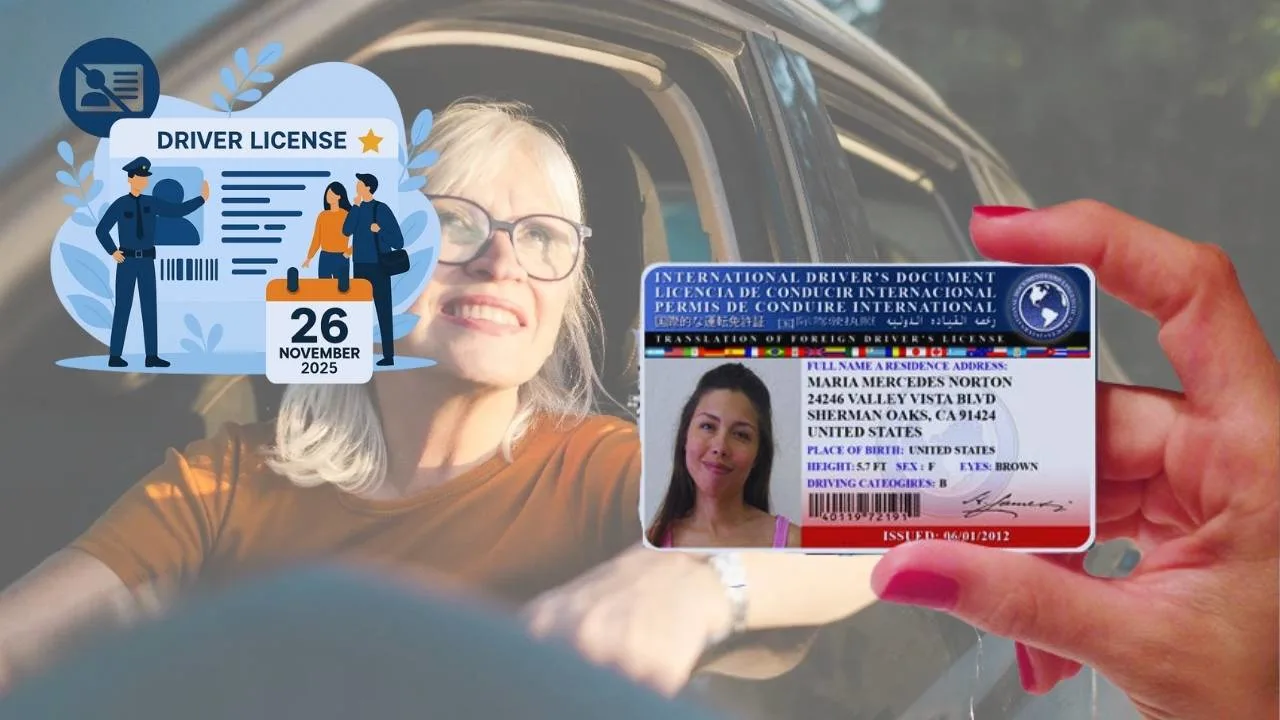The United States is about to undergo one of the biggest updates to its driving license system in decades. Starting 27 November 2025, several new rules will reshape how Americans prove their identity, renew their licenses, and even use their smartphones as digital IDs.
These changes — including the long-awaited REAL ID enforcement, tighter verification processes, and senior driver safety rules — are part of the government’s broader effort to modernize transportation security and improve road safety nationwide.
Transportation analyst Karen Douglas notes, “This transition isn’t just about bureaucracy — it’s about preparing the U.S. for a safer, smarter, and more digital future.”
U.S. Driving License Changes 2025
| Category | Major Change | Implementation Date |
|---|---|---|
| Federal ID | REAL ID mandatory for federal use | 27 November 2025 |
| Identity Verification | Stricter document and biometric checks | Ongoing in 2025 |
| Digital Licensing | Mobile driver’s licenses (mDLs) recognized in more states | Gradual rollout through 2026 |
| Senior Driver Rules | New renewal, testing, and vision requirements | State-by-state adoption |
| Data Coordination | State-federal database integration | National rollout 2025 |
REAL ID Requirement Becomes Mandatory
Beginning 27 November 2025, only REAL ID–compliant driver’s licenses or identification cards will be accepted for federal identification purposes.
These include:
- Boarding domestic flights
- Entering federal buildings
- Accessing military bases or secure federal facilities
REAL ID cards are easily recognized by a star marking in the upper corner. Regular licenses without the marking will remain valid for driving but cannot be used for federal identification.
According to the Department of Homeland Security (DHS), this policy ensures that all federal IDs meet modern security standards and are harder to forge.
Tighter Identity Verification Rules at the DMV
In an effort to combat identity theft and fraud, the Department of Motor Vehicles (DMV) will now require stricter documentation for license issuance and renewal.
Applicants must provide:
- Verified proof of identity (birth certificate or passport)
- Social Security number documentation
- Two verified proofs of address
- In select states, biometric data such as facial recognition or fingerprints
This added layer of security aims to reduce duplicate records and ensure that every issued license is legitimate.
Digital Driver’s Licenses: The Future Is Here
One of the most futuristic aspects of the reform is the expansion of digital or mobile driver’s licenses (mDLs).
These digital IDs are securely stored on smartphones and come with features like:
- Encrypted verification
- Biometric access control
- Scannable QR codes for law enforcement or airport security
- Instant updates for renewals or address changes
Currently, states such as Arizona, Maryland, and Georgia have already begun using mDLs, with more states preparing to follow in 2025 and 2026.
“In five years, most Americans will have their license stored in their digital wallet,” predicts Brian Lee, a cybersecurity expert at SecureID Technologies.
Updated Rules for Senior Drivers (Age 70+)
To improve safety on the roads, new rules will impact drivers aged 70 years and above. Depending on state legislation, these updates may include:
- Shorter renewal intervals (e.g., every two to three years)
- Mandatory in-person renewals
- Vision and cognitive testing
- Reaction-time assessments for high-risk drivers
These policies aim to balance independence for seniors with increased public safety.
Geriatric mobility expert Dr. Sandra Wright explains, “We’re not taking keys away — we’re making sure that older drivers have the resources and awareness to drive safely.”
Stronger Federal-State Coordination
In 2025, DMVs will integrate more deeply with federal databases for faster and more accurate identity verification. This collaboration includes:
- Cross-checking Social Security data
- Validating addresses against multiple databases
- Preventing duplicate licenses across state lines
This new system reduces the risk of identity fraud and helps states maintain accurate driver records nationwide.
Digital vs. Physical License Comparison
| Feature | Traditional License | Digital License (mDL) |
|---|---|---|
| Storage | Physical card | Smartphone app |
| Security | Photo and barcode | Encrypted biometric data |
| Renewal | In-person or by mail | Instant online update |
| Fraud Risk | Moderate | Significantly lower |
| Convenience | Carry in wallet | Integrated with digital ID wallet |
How to Prepare Before 27 November 2025?
To ensure a smooth transition, all drivers should take the following steps before the new rules take effect:
- Check if your license is REAL ID–compliant (look for the star marking).
- Visit your local DMV with all required documents well before the deadline.
- Set up your digital license, if available in your state.
- Review senior driver guidelines if you are 70 or older.
- Verify your personal data to ensure it matches federal records.
Delaying these steps could lead to long lines at DMVs and delays in license issuance closer to the implementation date.
Why These Changes Matter?
The 2025 driving license updates represent a significant move toward national identity security, technological modernization, and safer roads.
By combining physical security, digital innovation, and federal coordination, the U.S. is setting a new standard for identity management.
“These changes are not about control but about protection,” says Transportation Security consultant Alicia Morgan. “Your ID will be safer, smarter, and more efficient than ever before.”
Conclusion
The U.S. Driving License Changes of 2025 mark the beginning of a new chapter in American transportation and identity verification. Whether you’re a frequent traveler, a senior driver, or simply renewing your license, it’s crucial to stay informed and proactive before the 27 November 2025 deadline.
By adopting these new standards, the U.S. aims to make driving safer, identification more secure, and government processes more efficient for everyone.
FAQs – U.S. Driving License Changes 2025
What happens on 27 November 2025?
The REAL ID rule becomes mandatory for federal identification, and stricter verification protocols take effect nationwide.
What is the REAL ID used for?
REAL ID is required for boarding domestic flights, entering federal buildings, and accessing secure government facilities.
Can I still drive without a REAL ID?
Yes. A standard license remains valid for driving and local identification but not for federal use.
What documents are required for REAL ID?
You’ll need proof of identity, Social Security number, and two address documents.
Are digital licenses available everywhere?
Not yet. Availability varies by state, but adoption is expanding nationwide.
Are digital licenses safe?
Yes. They use encryption, authentication, and biometric verification for high security.
What about older drivers?
Drivers aged 70 and older may face more frequent renewals and mandatory vision tests under the new safety rules.

